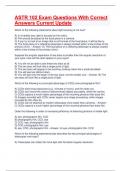Exam (elaborations)
ASTR 102 Exam Questions With Correct Answers Current Update
- Course
- Institution
ASTR 102 Exam Questions With Correct Answers Current Update Which of the following statements about light focusing is not true? A) In a healthy eye, light is focused on the retina. B) Film should be placed at the focal plane in a camera. C) If you try to look at an image that is not formed...
[Show more]



